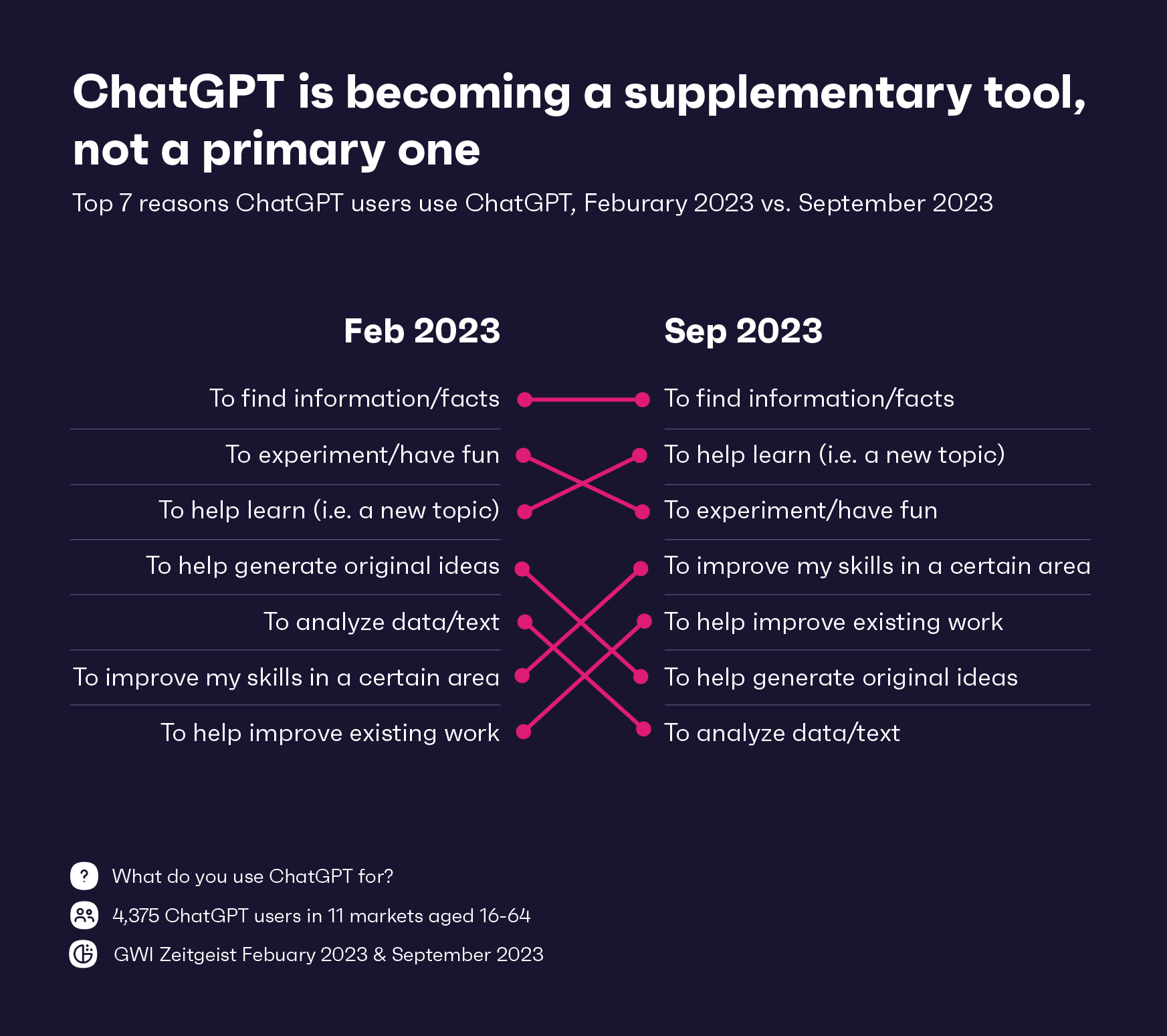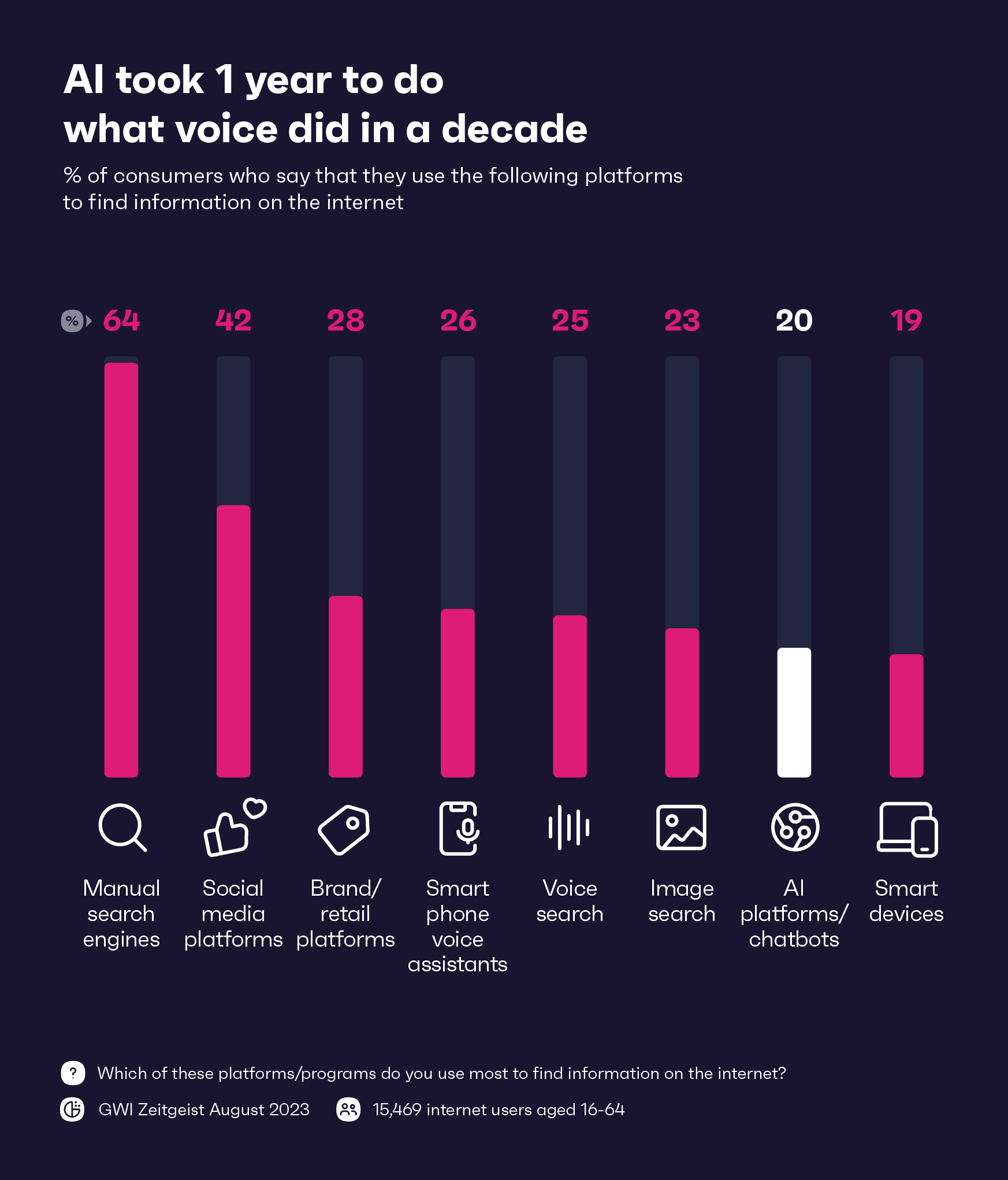ChatGPT, the AI chatbot from OpenAI, was released on November 30, 2022. Within 5 days it gained over 1 million users, making it an instant hit.
A year later it’s nothing short of a phenomenon, having revolutionized how we work, study, interact, and even how we gather data by scraping massive amounts of data from the open web and formulating human-like responses. In the latest premium version, ChatGPT is even capable of generating images, music, and speech, as well as text.
Consumers are excited about the vast potential of ChatGPT and AI as a whole. But some are increasingly aware of its shortcomings, while others have raised questions about privacy, industry, and ethics.
It’s fair to say a lot changes in a year and ChatGPT is no exception. In this blog, we’ll look at:
- How users are now approaching ChatGPT with different intentions
- Employees’ acceptance of AI in the workplace
- ChatGPT’s impact on online search
- How users’ perception of ChatGPT’s reliability are up, but helpfulness is down
- ChatGPT competitors who’ve come on the scene in the last year
- AI in creative industries and a new age for ethics
6 trending ChatGPT insights
1. Users are now approaching ChatGPT with different intentions
In February 2023, 57% of consumers in 11 markets had either never heard of ChatGPT, or had heard about it but weren’t sure what it was. Fast-forward to September 2023, and being in the dark about ChatGPT was far less common, with only 34% saying they’ve never heard of it or were unsure what it was. During the same period, the number who’ve used ChatGPT has nearly doubled.
In its first few months, consumers saw ChatGPT as a revelation. They were formulating original ideas and analyzing data and text, both of which are key components for the workplace and the classroom.

Information and fact-finding are still the #1 reasons to use ChatGPT. The number using it for heavy duty tasks like generating original ideas and analyzing text and data are falling, while the numbers using it for lighter tasks like improving existing work are up. Users still find it useful, but the chatbot is known for making up information – so-called hallucinations – when it doesn’t know the right answer, prompting users to play on the safe side and give it smaller, less complicated tasks.
With these lower stakes comes more trust. From February to September 2023, there was a 21% increase in consumers who thought ChatGPT was a tool they could use consistently.
There will always be consumers who push new applications like ChatGPT and other generative AI tools to do more. But for the average consumer, ChatGPT is becoming more of a copilot than an app that they can trust to take over any task.
2. Employees are becoming comfortable using AI in the workplace
Finding information, improving skills, and helping with existing work are the top reasons to use ChatGPT, making it a hit in the workplace. 24% of all consumers use ChatGPT or another AI tool at work on a daily basis, more than legacy tools like Dropbox and WebEx.
Tasks that require a certain tone of voice, such as customer service responses, internal emails, and social media posts, are all considered great workplace uses of AI.
The top industries that use AI tools on a daily basis are IT/telecommunications, software development, and education.
The widespread use of AI tools in the workplace has brought more acceptance. Over 6 in 10 of those who use AI at work are comfortable using it with coworkers, and 54% are comfortable using it with their boss.
As of May 2023, 31% of full-time employees think AI will allow them to save time on tasks, compared with only 22% who think AI will put jobs at risk. With ChatGPT usage trending towards checking existing work and away from formulating original ideas, the chances are they’ll be comfortable with current AI tools for a while.
3. ChatGPT continues to disrupt online search
Online search hasn’t seen much change since search engines like Google came along around 25 years ago. But social media has been a recent disruptor, especially among Gen Z, and ChatGPT and AI are making their mark there too.

The fact that 1 in 5 consumers use ChatGPT or another AI tool to find information online may not seem high, but in one year it’s already outpaced technologies that’ve been around for a decade.
ChatGPT can pull and consolidate information in seconds, whereas hunting down the same information via search engines or social media can take much longer. Chatbots can also offer a more tailored response, something that should appeal to its users as they’re 27% more likely than the average consumer to want brands to offer personalized products. Gen Z is especially likely to value personalization from a brand, and chatbots have found favor with them, with 54% more likely than the average consumer to use one to find information online.
While Google and Microsoft may have missed their moment to make an organic impact in social media, they’re eager to make their own chatbots a success, with Bard and Bing challenging OpenAI’s ChatGPT bot. Google is also expanding generative AI access in search, hoping to combine this powerful technology with a brand consumers already know and trust.
4. Reliability up, but at the cost of helpfulness
When ChatGPT first took the online community by storm, consumers’ fears of AI focussed on its seemingly limitless potential and what it might mean for their livelihoods. In fact worries about AI are the fastest-rising concern in the US, and continue to be on many consumer’s radars.
But the concern now is increasingly around reliability. ChatGPT and other generative AI tools learn by analyzing massive amounts of scraped data from the internet, which can obviously include false information, something consumers have been wary of for the last decade. On top of that, there are also recent reports of ChatGPT refusing to generate tasks users ask it to perform.
Not only is straightforward misinformation sometimes scraped up by AI chatbots, but biased information can be as well. 2 in 5 ChatGPT users worry about it being a biased tool, and the topic of bias in AI has been a hot topic over the past year.
Our data shows another interesting phenomenon. Those who see ChatGPT as unreliable are down 16%, but this fall has come at the expense of its perceived helpfulness.
Between February and September 2023, there was a 14% decrease in the number of ChatGPT users who said the tool was very helpful
Those who missed out on the initial hype may have had their expectations raised by earlier users of ChatGPT, only to find it a bit underwhelming when they finally get stuck in.
At the same time the number of ChatGPT users who said they’d be willing to pay for a premium version has fallen 15% from February to September 2023, which is bad news considering the incredibly high cost of running AI chatbots. OpenAI will have to address concerns around this, or another chatbot focused on reliability and accuracy may win over consumers.
5. ChatGPT competitors – who’s come on the scene in the last year?
ChatGPT is by far the best known generative AI chatbot, but other apps have come onto the market in the last year, from both AI-focused startups and legacy tech companies. These include Google’s Bard (equipped with the search giant’s latest language model, Gemini) and Microsoft’s Bing AI chatbot. Bing has benefited from OpenAI’s GPT-4 – the language model used in their chatbot – seeing a 16% increase in usage since Q4 2022.
Social media is also joining in the chatbot game, with Snapchat and X (formerly Twitter) coming out with their own AI chatbots in an attempt to keep users using their apps. X’s bot, Grok, has gained attention due to Elon Musk pitching it as a funny/vulgar alternative to traditional AI, playing on the fact that with over half of ChatGPT users talking to AI like it’s a real person, giving Grok a strong personality might appeal to users.
With startups and pre-existing companies all scrambling to get a slice of the AI pie, consumers will pick their preferred platform based on its trustworthiness, recency, and safety – the key attributes in a chatbot.

Although we touched on the importance of trustworthiness above, it can’t be overstated. Consumers don’t want to have to fact-check a chatbot’s output, and with ChatGPT users shifting to using the platform to check existing work and improve skills rather than generate original ideas, their faith in the platform’s accuracy might be slipping.
Data freshness is another potential issue. ChatGPT only uses up-to-date information pulled from Bing for its premium subscribers; free users are currently stuck using information from January 2022,.
Safety is another concern. Confidential information often finds its way into the open web, which can then be scraped up by chatbots. ChatGPT and other AI chatbots will need to prioritize protecting consumer data and be transparent with users about where they source information, as well as doing their best to make sure personal data isn’t used for learning purposes.
6. AI in creative industries & a new age for ethics
Consumers have made it clear there are limitations on how they think AI should be used, especially in art and music.
As of November 2023, 58% of consumers think that AI tools are capable of producing real art and music, an increase of 17% when asked the same question in April. While consumers are more likely to accept AI art with more exposure, they also want to protect existing art and human-created art.
Over half of consumers think that AI tools are capable of producing real art/music
A majority of Americans supported the writers/actors strike in 2023, and one of the biggest things they were striking against was the use of AI in creative works. And globally, nearly half of consumers disagree that AI tools should be allowed to use copyrighted material or be allowed to imitate human-created art without legal implications.
What this means is that, at minimum, AI-generated content should be labeled as such. Over 4 in 5 consumers want this, and while some AI-generated content is undoubtedly harmless and good fun, it can be harmful to a brand’s reputation if AI use isn’t disclosed, or if a brand uses AI when they previously said they wouldn’t. Consumers want brands to be reliable and authentic, and being open about AI use is the latest example of this concern.
Brands are already starting to act. YouTube requires creators to add labels to content that contains “realistic” AI-generated content, and Adobe has added labels to give users information about any AI-generated images within a file.
In conclusion
ChatGPT arguably had the most impressive first year of any brand, online or offline. In one year, it successfully disrupted online search, ethics, the workplace, and many other fields.
But in their second year, OpenAI and ChatGPT will have to adapt to challenges thrown at them by users and competitors.
Consumers initially saw ChatGPT as an ambitious and revolutionary tool, but a year later, they’re treating it like an assistant or copilot. Specifically they want a chatbot that delivers on three things – trustworthiness, up-to-date information, and protecting consumer data.
ChatGPT, or indeed any AI chatbot, can score trust points by putting in place robust misinformation and personal information detectors when scraping data, and regularly updating the information they make available for consumers.
It’s also important to note that ChatGPT isn’t the only kid on the AI block, even if they’re still the best known chatbots. Legacy tech companies like Google and Twitter have launched their own chatbots, and their existing infrastructure and user bases have the potential to challenge ChatGPT in the coming year.
A lot changes in a year, and 2024 is set up to be an important one for AI. Watch out for any developments here.




